Désirée van der Heijde, MD, PhD, learned early in her career that serendipity often plays a role in clinical research and treatment advances. She devoted her PhD thesis to the development of the Disease Activity Score (DAS), under the supervision of her mentor Piet van Riel, MD, PhD.1 In the course of that work, she also expanded upon radiographic assessment with the van der Heijde modification of the Sharp score, which became the standard in measuring radiographic progression in rheumatoid arthritis (RA).2 Then, in the late 1990s, pharmaceutical companies were searching for standardized assessments to test the efficacy of biologics for rheumatoid arthritis. The DAS and the Sharp score fit the bill, and the ability to evaluate new treatments with consistent metrics led to an exponential advancement in treatments for RA.3
Currently professor of rheumatology at Leiden University Medical Center in the Netherlands as well as a senior researcher at Diakonhjemmet Hospital in Oslo, Norway, Dr. van der Heijde reflects on the meteoric progression of RA treatments: “You need to be a little bit lucky when you develop something. We had all the measures ready when the new drugs became available and then they wanted to have outcomes measures for assessing them.”
Those who have known and collaborated with Dr. van der Heijde would argue that she has made her luck by devoting her intellectual drive and organizational abilities to furthering clinical research methodologies. This has been especially true in the field of spondylarthritis. Since 1994, when she became assistant professor in Sjef van der Linden’s department of rheumatology at the University Hospital Maastricht, in the Netherlands, she has worked intensely with a dedicated core of colleagues who comprised the original AS Working Group. Following the principles of the Outcome Measures in Rheumatoid Arthritis Clinical Trials (OMERACT) process, the group began development of response and remission criteria for ankylosing spondylitis (AS), and formally organized in 1995 as the Assessment of SpondyloArthritis international Society (ASAS). Again, the instruments were in the right place at the right time. And the result, says Robert B. M. Landewé, MD, professor of rheumatology at the Academic Medical Center of the University of Amsterdam, is that “further development of these drugs [the biologics] went rocket fast.”4 Whereas it took 15 years to develop biologics as efficacious treatments in RA, it took only a few years to secure approvals for their indication in AS.
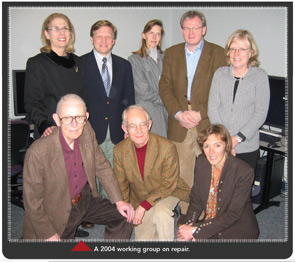
Attraction to Research
Dr. van der Heijde does not recall a time when she was not interested in medicine. Her curiosity, at an early age, about the body and how it works fueled her choice to enter premed training immediately after high school. First attracted to pediatrics, she changed her mind after a clerkship in internal medicine. Her first rotation was in rheumatology, where she met Dr. van Riel, who was then a rheumatologist and researcher at University Hospital in Nijmegen. She was drawn to rheumatology precisely because her patients had chronic disease. “What I liked a lot,” she notes, “was the [opportunity to] establish a longstanding relationship with patients.”
Dr. van Riel had already initiated his early arthritis clinic, and the department had received a government grant for clinical research. Dr. van der Heijde had found a perfect fit. “I’ve never been attracted to basic science,” she says. “It was the clinical aspect of research that attracted me most.” She accepted Dr. van Riel’s invitation in 1986 to join the program; the early RA clinic cohort became the subjects for her PhD thesis. Listen to Dr. van der Heijde reflect on working with Dr. van Riel to develop the Disease Activity Score.
Dr. van der Heijde plowed into the laborious work of collecting radiographs in the early arthritis clinic, which also included patients of Dr. van Riel’s earlier randomized clinical trials comparing sulfasalazine with hydroxychloroquine. He had done work during his PhD thesis on a disease activity outcome measure, but believed a better one was needed. His idea was the impetus for the development of the DAS. Dr. van der Heijde acquired more help from statistician Martin van’t Hof, PhD, who, she says, “didn’t just give me results from the data, but always worked through the methods together with me. I learned a lot from him about handling databases, which I have used in all the years afterwards.”
Elisabeth Lie, MD, PhD, currently with the department of rheumatology at Diakonhjemmet Hospital, has benefitted from Dr. van de Heijde’s conversance with statistics. Dr. Lie’s work has centered on the Norwegian disease-modifying antirheumatic drug register, the five-center Norwegian register established in 2000. “Dr. van der Heijde has been involved with helping me find the right angle and more interesting, up-to-date research questions and has been a very good support regarding the methodological side of these projects,” says Dr. Lie.
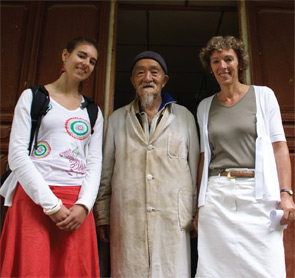
Fellows Will Follow
Dr. van der Heijde interspersed research with her doctoral training, finishing her PhD thesis in 1991 and her training in 1993. She then chose to continue research in the pharmaceutical arena, as a medical advisor in rheumatology at Kabi Pharmacia AB in Uppsala, Sweden. After a year, though, she realized, she says, that “it was not the best place for me,” and returned to academia in 1994, accepting Dr. van der Linden’s invitation to join his program and focus on spondylarthritis.
Maxime Dougados, MD, professor of rheumatology at René Descartes University and chair of the department of rheumatology at the Cochin Hospital in Paris, has devoted his research to outcome measures in the rheumatic diseases. He recalls foundational discussions in the early 1990s among a core group of AS experts (including Drs. van der Linden and van der Heijde) to convince the U.S. Food and Drug Administration to revisit its guidelines on conducting clinical trials in AS. “From the beginning,” he recalls, “we decided not to work as individuals proposing and elaborating our own outcome variables, but to work as a collaborative team.” Dr. van der Heijde’s talents for collaboration, he says, have been particularly valuable in this process. “She has an open mind, and from the start she not only looks at the first or proximal step, but is always anticipating the next steps. She’s a fantastic organizer, and has done very good work as president of ASAS,” says Dr. Dougados. “And at the same time, she is a very good trainer and professor. To be able to attract Désirée to your department, you know in advance that you will have plenty of fellows who will follow.”
Dr. Lie reported that initially she felt a bit daunted by the challenge of working with such an esteemed research scientist. “I really felt that I had to be prepared and tried to be my best during our discussions. But the way she has done her supervision has been very balanced. She would hear you out, and then come in with just the right amount of input to move the process further. She has a very efficient, but also very friendly way of supervising her PhD students.”
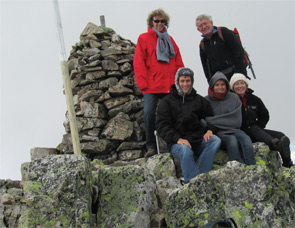
Versatile Collaborator
In 2007, Tore K. Kvien, MD, PhD, professor of rheumatology at the University of Oslo and head of the department of rheumatology at Diakonhjemmet Hospital, had heard that Dr. van der Heijde had moved from Maastricht to Leiden and invited her to become a senior researcher in his department. His main impetus for doing so: “Désirée is a very nice and collaborative person, supportive, extremely intelligent, and we felt it would be a great opportunity for her to help supervise research fellows.” His instincts have been borne out. For example, he says, Dr. van der Heijde has been “extremely important” for the development of the protocol in the Aiming for Remission in Rheumatoid Arthritis (ARCTIC) trial, an ongoing study headed by postdoc Espen A. Haavardsholm comparing conventional assessment and ultrasonography as treatment targets in RA.
“From our perspective,” Dr. Kvien says, “she is not only a very brilliant person, but she is very organized, and always on time.” She and her oldest daughter have spent time at Dr. Kvien’s cabin in the Norwegian mountains. There they have taken hikes, climbing up to 5,184 feet. “That’s very unusual, you know, for Dutch,” he jokes. He admires his colleague’s curiosity and willingness to try new things. “So, although she’s always organized and delivering, it’s always in a friendly and relaxed way,” he says.
Colleagues and trainees alike admire Dr. van der Heijde’s productivity. Despite a full travel schedule and double appointments at both Leiden and Oslo, she manages to monitor her trainees’ projects and stay involved with the numerous society and organizational initiatives with which she is involved. “She is very focused, and there is not a better planner in the world,” says Dr. Landewé.
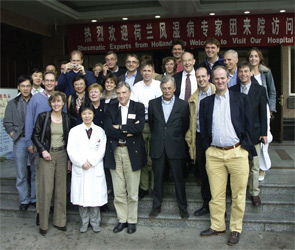
Ida Haugen, MD, would second that notion. Currently conducting research for her thesis on magnetic resonance imaging (MRI) in osteoarthritis at Diakonhjemmet Hospital, she appreciates Dr. van der Heijde’s availability and her facility with developing scoring systems, an additional challenge when using MRI because of the density of data in images. “If you have a question and don’t really know what to do, she understands really quickly what the problem is,” Dr. Haugen says. “She has a clear answer about how to proceed and you can continue with the rest of the work.”
Spondylarthritis and outcomes research have been Pedro Machado’s primary research interest, so when it came time to choose a fellowship program in 2008, he looked to Tom Huizinga’s center of excellence at Leiden University Medical Center, in the Netherlands. Knowing that Dr. van der Heijde, a spondylarthritis expert, had an appointment there “made the choice quite easy,” he says. He began work on his PhD thesis in 2010 and is focusing on health outcomes and imaging in axial spondylarthritis. He’s found Dr. van der Heijde’s advice particularly valuable, since knowledge about outcomes research is central to his work. “I think it’s important that you admire your supervisor’s work, and I think you have to find that work exciting, in order for the relationship to work out,” Dr. Machado observes. “For me, Désirée is such a person.”
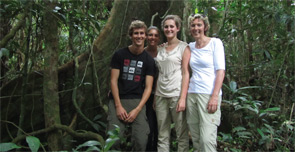
Rewards and Future Challenges
As a young researcher, Dr. van der Heijde had the chance to meet an established American rheumatologist whose work she not only knew and admired, but had adapted for the Nijmegen early arthritis cohort. She was presenting her data from the RA study in poster form at the ACR Annual Scientific Meeting when John Sharp, MD, approached her. “That,” she recalls, “was the beginning of a very nice working relationship and friendship.” From the first publication of the van der Heijde modification of the Sharp score, Dr. van der Heijde has continued to refine and explicate this important radiologic assessment so core to assessing damage in RA. She and Dr. Sharp worked together for many years on different projects, until the year of his death in 2008. Both were part of a core subcommittee on healing of erosions in RA, taking the assessment process to a qualitatively new level.5 “It was always very stimulating to work with him, and I always listened very carefully to his commands because they were always important,” she says.
In addition to over 450 manuscripts in peer-reviewed journals (86 as first author), many letters to journal editors, 38 book chapters, and editing five textbooks, Dr. van der Heijde has been intensely involved in the OMERACT process. She has attended each conference from its beginnings in 1992 in Maastricht (except for one when she gave birth to her second daughter). A member of the OMERACT steering group since 2004, she has chaired numerous subcommittee working groups, from the Imaging Working Group on Plain Films, to one on scoring methods for MRI of the sacroiliac joints and spine, to one on biomarkers of outcome measures in RA. In 2010, in Borneo, she was one of the organizers of the Sharp symposium as part of OMERACT.
She works tirelessly to refine clinical trial methodologies, and sees challenges ahead. Most researchers point to the challenges posed by raising funds, but Dr. van der Heijde also foresees a need to develop new trial designs that will make it possible to show efficacy of future treatments. Part of the problem, she says, is that, “it’s more and more difficult to find the correct patients for clinical trials, especially in the Western world.” Of course, that’s a good sign, because treatments have improved so much. Adaptive trial design might be one innovation that would allow comparability of treatments. To do this, she says, will require convincing regulatory agencies to accept new ways of trial design, comparators, and analyses. A veteran of the collaborative process, Dr. van der Heijde will likely be among those to keep driving the field forward. For, as she well knows, “luck is what happens when preparation meets opportunity” (Seneca).
Gretchen Henkel is writing the “Metrics in Rheumatology” series.
Timeline
- 1984 –•Earns her MD from Catholic University Nijmegen
- 1991 –•Earns her PhD
- 1993 – Becomes medical advisor in rheumatology at Kabi Pharmacia AB
- 1994 –•Becomes assistant professor in rheumatology at the University Hospital Maastricht
- 1998 –•Becomes associate professor in rheumatology at the University Hospital Maastricht
- 2000 –•Becomes guest professor in rheumatology at Limburg University Center in Diepenbeek, Belgium
- 2001 –•Becomes professor in outcome assessment in musculoskeletal disorders at Maastricht University
- 2004 –•Becomes a member of the OMERACT steering group
- 2007 –•Becomes senior researcher at Diakonhjemmet Hospital
- 2007 –•Becomes professor in rheumatology at Leiden University Medical Center
References
- van der Heijde DMFM, van ‘t Hof MA, van Riel PLCM, van Leeuwen MA, van Rijswijk MH, van de Putte LBA. A comparison of validity of single variables and composed indices for measuring disease activity in rheumatoid arthritis. Ann Rheum Dis. 1992;51:177-181.
- van der Heijde DMFM, van Riel PLCM, Nuver Zwart HH, Gribnau FWJ, van de Putte LBA. Effects of hydroxychloroquine and sulfasalazine on progression of joint damage in rheumatoid arthritis. Lancet. 1989;1:1036-1038.
- Lipsky P, van der Heijde D, St. Clair EW, et al, for the Anti-Tumor Necrosis Factor Trial in Rheumatoid Arthritis with Concomitant Therapy Study Group. Infliximab and methotrexate in the treatment of rheumatoid arthritis. New Engl J Med. 2000;343:1594-1602.
- Davis J, van der Heijde D, Braun J, et al, for the Enbrel Ankylosing Spondylitis Study Group. Recombinant human tumor necrosis factor receptor (etanercept) for treating ankylosing spondylitis, a randomized, controlled trial. Arthritis Rheum. 2003;48:3230-3236.
- Sharp J, van der Heijde D, Boers M, et al, for the Subcommittee on Healing of Erosions of the OMERACT Imaging Committee. Repair of erosions in rheumatoid arthritis does occur: Results from two studies by the OMERACT subcommittee on healing of erosions. J Rheumatol. 2003; 30:1102-1107.